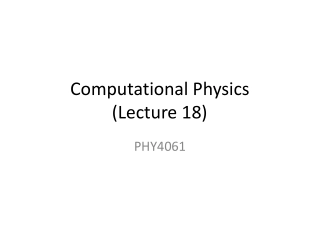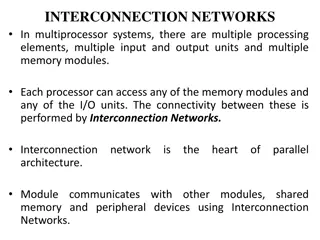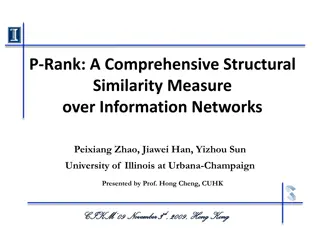Classes of networks
This content delves into various classes of networks including acyclic directed networks, algorithms to check for acyclicity, vertex layouts, and hypergraphs. It also explores bipartite networks and their transformation from hypergraphs, offering insights into different network structures and properties.
Download Presentation

Please find below an Image/Link to download the presentation.
The content on the website is provided AS IS for your information and personal use only. It may not be sold, licensed, or shared on other websites without obtaining consent from the author.If you encounter any issues during the download, it is possible that the publisher has removed the file from their server.
You are allowed to download the files provided on this website for personal or commercial use, subject to the condition that they are used lawfully. All files are the property of their respective owners.
The content on the website is provided AS IS for your information and personal use only. It may not be sold, licensed, or shared on other websites without obtaining consent from the author.
E N D
Presentation Transcript
Acyclic directed network Acyclic network: a network has no cycles. Citation network is acyclic (a paper can only cite another paper if it has already been written). Vertices are laid out in such a way that all edges point downward.
Vertices are laid out in such a way that all edges point downward For an acyclic network, there must be a vertex without outgoing edges. Draw this vertex at the bottom. Remove that vertex from the original acyclic network and all the edges attached to it. Repeat the process. Choose one of them 5 4 2 3 1
An algorithm to check whether a network is acyclic 1. Find a vertex with no outgoing edge. 2. If no such vertex exists, the network is cyclic. Otherwise, if such a vertex does exist, remove it and all its incoming edges from the network. 3. If all the vertices have been removed, the network is acyclic. Otherwise, go back to Step 1.
Vertices are laid out in such a way that all edges point downward There can be an edge from vertex j to vertex i if j>i. The adjacency matrix is strictly upper triangular (upper triangular with the diagonal element being all 0). 1 2 3 4 5 5 1 2 3 4 5 4 A= 2 3 1 Through relabling, any acyclic network has a strictly upper triangular adjacency matrix. All the eigenvalues of the adjacency matrix of an acyclic network are 0. (this is necessary and sufficient)
Hypergraphs Hyperedge: an generalized edge that joins more than two vertices. A hyperedge is a group of vertices. Hypergraph: a graph with hyperedges. Affiliation networks: films and actors. A 1 4 B 3 D C 2 5
Bipartite networks Transform a hypergraph into a bipartitie network (two-mode network) There are two kinds of vertices, one representing the original vertices and the other representing the groups to which they belong. A A B C D 1 4 B 3 D C 2 5 1 2 3 4 5
Bipartite networks Another example: two kinds of vertices correspond to men and women and the edges between them marriage Incidence matrix B (g n matrix) Bij=1 if vertex j belongs to group i
One-mode projections A B C D Films Actors 1 2 3 4 5 6 7 Two actors are connected if they appeared in the same film. 7 2 5 6 1 Two films are connected if they have the same actor. 3 4 A B D C
Trees A tree is a connected, undirected network that contains no closed loops. Root and leaves Root Leaves There is exactly one path between any pair of vertices. A tree of n vertices contains exactly n-1 edges. (Prove by induction)
Planar networks A planar network is a network that can be drawn on a plane without having any edges cross. River networks, road networks Four color theorem: one needs at most four colors to color a planar graph so that no two connected vertices have the same color. (Prove by computer for many cases) Chromatic number of a graph: the number of colors needed to color the graph.
Degree The degree of a vertex is the number of edges connected to it. ki: the degree of vertex i m: number of edges 2m ends of edges (every edge has two ends)
Mean degree c: the mean degree of a vertex in an undirected graph The maximum possible number of edges is (n-1)n/2.
Density Density (connectance): the fraction of the maximum number of edges that actually present For large network (n is very large)
Density A (large) network is said to be dense if the density tends to a constant as On the other hand, it is said to be sparse if tends to 0 as
Regular graphs A regular graph is a graph in which all the vertices have the same degree. k-regular graph: every vertex has degree k 2-regular: ring 4-regular: square lattice
Degree in directed networks In-degree: the number of incoming edges Out-degree: the number of outgoing edges
Degree in directed networks m: the number of edges The mean in-degree and the mean out-degree are equal
Path Path: a sequence of connected vertices Self-avoiding path: a path that does not intersect itself Length of a path: the number of edges in the path If there is a path of length 2 from j to i via k, then AikAkj=1.
Paths and adjacency matrix : the number of paths of length 2 from j to i : the number of paths of length 3 from j to i
Paths and adjacency matrix : the number of paths of length r from j to i Loop: the start vertex and the end vertex of a path are the same Lr: the total number of loops of length r
The number of loops in an undirected graph The adjacency matrix A in an undirected graph is symmetric. It has n real eigenvaues. It is diagonizable and there exists an orthogonal matrix U such that Where K is a diagonal matrix of eigenvalues.
The number of loops in an undirected graph Where is the itheigenvalue of the adjacency matrix A
The number of loops in an directed graph The adjacency matrix is not symmetric. It may not be diagonizable Schur theorem: there is an upper triangular matrix T and an orthogonal matrix Q such that
The number of loops in an directed graph Suppose k is an eigenvalue of A with the eigenvector x, i.e., Then k is also an eigenvalue of T with the eigenvector This also shows that the eigenvalues of the adjacency matrix A of an acyclic network are all 0.
Geodesic paths A geodesic path (shortest path) is a path between two vertices that no shorter path exists Geodesic distance (shortest distance): the length of a geodesic path The smallest value r such that Geodesic paths are self-avoiding (Why?) Geodesic paths are not necessarily unique
Diameter The diameter d of a graph is the length of the longest geodesic paths between any pairs of vertices in a network. Suppose that is the geodesic distance between vertices i and j
Eulerian path and Hamiltonian path Eulerian path: a path that traverses each edge in a network exactly once. Hamiltonian path: a path that visits each vertex in a network exactly once. (self-avoiding) A Eulerian path is not necessarily self- avoiding.
Knigsberg bridge probelm 4 land masses, 7 bridges Does there exist a walking route that crosses every bridge exactly once? Eulerian path A network can have an Eulerian path only if there are exactly two or zero vertices of odd degree
Components A network is connected if there is a path from every vertex to any other vertex. Disconnected networks can be separated into several components. Components: There is a path from every vertex in the subnetwork to any other vertex in the same subnetwork. No other vextex can be added while preserving this property.
Components in directed networks Weakly connected: ignored the directed nature of edges Strongly connected: there is a directed path from every vertex to any other vertex. Out-component of a vertex A: the set of vertices that can be reached by directed paths from vertex A and including A itself. In-component of a vertex A: the set of vertices from which there is a directed path to A, including A itself.























